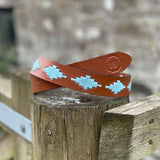The Story Behind The Polo Belt
It’s widely recognised that the Argentine polo belt is synonymous with polo and the sport’s rich heritage; but how many of us know the story behind the polo belt, and how it became a fashion statement that would stay prominent through the decades?
The polo belt has become a popular trend far beyond the realms of the sport of polo itself; equestrians all over the world are sporting the accessory with pride and over recent years, it has revived itself as a staple part of the English countryman or woman’s wardrobe.
The original polo belt came from modest beginnings; the gaucho inspired leather belts were crafted for polo teams, decorated in their patron’s colours. Argentina has long been known for its skill and craft with leather goods, and the tradition continues today.
A brief history of the sport of Polo
Polo is often hailed as the ‘sport of kings’. Polo was played many moons ago by Iranian and Turkic equestrian nomads in central Asia, with the current form originating in Iran, spreading east and west and eventually across the globe. Polo became a Persian national sport that was played by the rich and the noble and was highly regarded by kings and royalty. It’s unclear as to the exact origins of the sport, but certainly polo dates back to 247 BC and beyond.
Fast forward centuries later and we have the modern game of polo, although Argentina is famous for its polo, the game of polo was actually derived in India and was known as ‘pulu’. The first Mighal emperor, Babur, popularised the sport in India, which made a significant influence in England.
Later, British and Irish immigrants in the Argentine pampas began playing polo for enjoyment and the sport began to spread throughout the gauchos, resulting in several clubs opening. Soon, Argentina became globally recognised as the home of polo and thus the modern sport as we know it was born.
The Argentine Polo belt
We digress, the history of polo as the sport itself is an in-depth topic of discussion that is perhaps best saved for another article – after all, you came here to read about the origins of the polo belt didn’t you?
As a nation of highly skilled and gifted horseman, it’s no wonder that polo soon became famed in Argentina. For polo players, the colourful leather belts were simply part of the team uniform, sporting the team colours, woven in pampa diamonds across the leather to distinguish each team from another. Symbolically, the leather came from the cows that the gauchos themselves herded to make a living.
As polo grew and became a sensation throughout Argentina and beyond, the style of the polo belts became coveted and people from all backgrounds sought them, buying them from flea markets and stores across the country.
These days, polo belts are made all over the world, but the authentic polo belt is crafted in Argentina, just as it was at the beginning. The style is applied to many leather goods, such as head collars and more, and continues to enjoy its revival in the UK and beyond.
Georgian Dollar are proud to continue the tradition of the polo belt, as our polo belts and head collars are crafted in Argentina, using the finest saddle leather. It’s a trend that has become iconic over the years, and shows no sign of going out of vogue.



